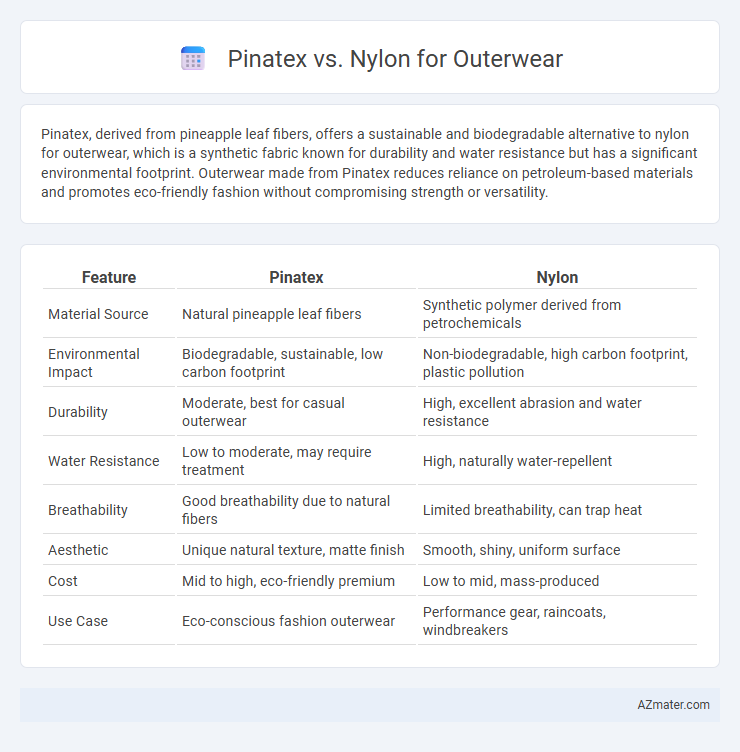Pinatex, derived from pineapple leaf fibers, offers a sustainable and biodegradable alternative to nylon for outerwear, which is a synthetic fabric known for durability and water resistance but has a significant environmental footprint. Outerwear made from Pinatex reduces reliance on petroleum-based materials and promotes eco-friendly fashion without compromising strength or versatility.
Table of Comparison
| Feature | Pinatex | Nylon |
|---|---|---|
| Material Source | Natural pineapple leaf fibers | Synthetic polymer derived from petrochemicals |
| Environmental Impact | Biodegradable, sustainable, low carbon footprint | Non-biodegradable, high carbon footprint, plastic pollution |
| Durability | Moderate, best for casual outerwear | High, excellent abrasion and water resistance |
| Water Resistance | Low to moderate, may require treatment | High, naturally water-repellent |
| Breathability | Good breathability due to natural fibers | Limited breathability, can trap heat |
| Aesthetic | Unique natural texture, matte finish | Smooth, shiny, uniform surface |
| Cost | Mid to high, eco-friendly premium | Low to mid, mass-produced |
| Use Case | Eco-conscious fashion outerwear | Performance gear, raincoats, windbreakers |
Introduction to Piñatex and Nylon
Pinatex is an innovative sustainable material made from pineapple leaf fibers, offering a biodegradable alternative to traditional textiles with a leather-like appearance and durability. Nylon, a synthetic polymer, is known for its lightweight, water-resistant, and highly durable properties, commonly used in outerwear for protection against harsh weather. Both materials cater to performance and sustainability, with Pinatex emphasizing eco-friendliness and Nylon focusing on technical resilience.
Origins and Production Processes
Pinatex is a sustainable textile made from pineapple leaf fibers, harvested as an agricultural byproduct in the Philippines, offering an eco-friendly alternative to synthetic fabrics. Its production involves a low-impact process that repurposes waste material, reducing deforestation and water consumption compared to traditional nylon manufacturing. Nylon, derived from petrochemicals through energy-intensive polymerization, relies heavily on fossil fuels and contributes significantly to greenhouse gas emissions in outerwear production.
Material Composition and Structure
Pinatex is a sustainable alternative made from pineapple leaf fibers, offering a natural, breathable, and biodegradable structure ideal for eco-conscious outerwear. Nylon, a synthetic polymer derived from petrochemicals, provides durable, water-resistant, and lightweight properties suited for high-performance jackets. The distinct fiber composition of Pinatex results in a textured, organic feel, while nylon's tightly woven filaments create a smooth, resilient fabric optimized for weather resistance and longevity.
Durability and Performance in Outerwear
Pinatex, made from pineapple leaf fibers, offers eco-friendly durability but tends to be less resistant to abrasion and moisture compared to nylon. Nylon excels in outerwear performance due to its high tensile strength, water resistance, and quick-drying properties, making it ideal for harsh weather conditions. While Pinatex suits sustainable fashion, nylon remains the preferred choice for long-lasting, high-performance outerwear.
Comfort and Wearability
Pinatex offers superior breathability and moisture-wicking properties compared to nylon, enhancing overall comfort for outerwear users. The natural pineapple leaf fibers in Pinatex provide flexibility and softness, reducing skin irritation often associated with synthetic nylon fabrics. Nylon, while durable and water-resistant, tends to trap heat and cause discomfort during prolonged wear or active use.
Weather Resistance and Maintenance
Pinatex outerwear offers excellent breathability and moderate water resistance due to its natural pineapple leaf fiber composition, making it suitable for light rain but requiring prompt drying to prevent mold growth. Nylon outerwear provides superior weather resistance with high water repellency and windproof qualities, ensuring durability in heavy rain and harsh conditions with minimal maintenance. Maintenance for Pinatex involves gentle cleaning and conditioning to preserve its fibers, while nylon requires simple washing and occasional reapplication of durable water repellent (DWR) coatings to maintain optimal performance.
Environmental Impact and Sustainability
Pinatex, derived from sustainable pineapple leaf fibers, offers a biodegradable and renewable alternative to traditional nylon, which is petroleum-based and non-biodegradable. The production of Pinatex generates significantly lower carbon emissions and reduces plastic pollution compared to nylon, contributing to a more eco-friendly outerwear market. Choosing Pinatex supports circular fashion principles by utilizing agricultural waste, whereas nylon's environmental footprint includes microplastic shedding and long decomposition times in landfills.
Aesthetic Qualities and Design Versatility
Pinatex offers a unique, natural texture with a matte finish that enhances outerwear with an eco-friendly, artisanal aesthetic, contrasting Nylon's smooth, glossy surface that conveys a sleek, modern look. The breathability and pliability of Pinatex allow for innovative design details such as lightweight drapes and organic shapes, while Nylon's superior stretch and water resistance support functional, streamlined silhouettes ideal for performance wear. Designers prioritize Pinatex for sustainable luxury and tactile appeal, whereas Nylon dominates in technical versatility and resilience across diverse climate conditions.
Cost Comparison and Market Availability
Pinatex outerwear generally costs more than nylon due to its innovative pineapple leaf fiber composition and sustainable production methods, with prices often ranging from $150 to $300 per jacket compared to nylon's $50 to $150 range. Market availability of Pinatex remains limited to niche and eco-conscious brands, predominantly in Europe and North America, while nylon outerwear is widely accessible globally through mass-market retailers and outdoor brands. The growing consumer demand for sustainable materials is gradually increasing Pinatex's presence, though nylon retains a cost advantage and greater distribution channels in mainstream outerwear.
Future Trends in Outerwear Fabrics
Pinatex, an innovative sustainable fabric made from pineapple leaf fibers, is gaining traction as an eco-friendly alternative to traditional nylon in outerwear, offering biodegradability and a lower carbon footprint. Nylon, renowned for its durability and water resistance, continues to dominate the market but faces growing scrutiny due to its fossil-fuel dependence and environmental impact. Future trends in outerwear fabrics emphasize blending sustainable bio-based materials like Pinatex with performance-enhancing technologies to meet consumer demand for eco-conscious yet functional apparel.

Infographic: Piñatex vs Nylon for Outerwear
 azmater.com
azmater.com